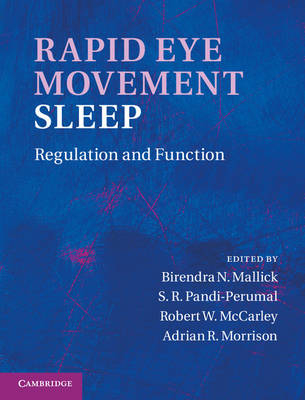
Rapid Eye Movement Sleep
Cambridge University Press (Verlag)
978-0-521-11680-0 (ISBN)
Spanning over half a century of investigation into Rapid Eye Movement (REM) sleep, this volume provides comprehensive coverage of a broad range of topics in REM sleep biology. World renowned researchers and experts are brought together to discuss past and current research and to set the foundation for future developments. Key topics are covered in six sections from fundamental topics (historical context and general biology) to cutting-edge research on neuronal regulation, neuroanatomy and neurochemistry, functional significance and disturbance in the REM sleep generating mechanism. A reference source for all aspects of REM sleep research, it also incorporates chapters on neural modelling, findings from non-human species and interactions between brain regions. This is an invaluable resource, essential reading for all involved in sleep research and clinical practice.
Birendra Nath Mallick is Professor of Neurobiology at Jawaharlal Nehru University, New Delhi, India. S. R. Pandi-Perumal is President and CEO of Somnogen Inc., a New York corporation. Robert W. McCarley is Professor and Chair of the Harvard Department of Psychiatry and Associate Director of Mental Health in the VA Boston Healthcare System, Boston, USA. Adrian R. Morrison is Professor Emeritus of Behavioral Neuroscience at the School of Veterinary Medicine, University of Pennsylvania.
Part I. REM Sleep as a Unique Arousal State – Historical Context: 1. The sleep-dream state – historic and philosophic perspectives; 2. REM sleep and dreaming; 3. REM sleep and dream sleep: are they identical? Exploring the conceptual developments in the Upanishads and the present knowledge based on neurobiology of sleep; 4. The discovery of REM sleep: the death knell of the passive theory of sleep; 5. REM sleep and dreaming: the nature of the relationship; Part II. General Biology: 6. The ontogeny and function(s) of REM sleep; 7. Evolutionary perspectives on the function of REM sleep; 8. A systems level approach to human REM sleep; 9. REM sleep regulation: circadian, homeostatic and non-REM sleep-dependent determinants; Part III. Neuronal Regulation: 10. Understanding REM sleep: clues from brain lesion studies; 11. Preoptic and basal forebrain modulation of REM sleep; 12. Amygdalar regulation of REM sleep; 13. Pontomedullary mediated REM sleep atonia; 14. Phenomenology and function of myoclonic twitching in developing rats; 15. Pontine-wave (P-wave) generator: a key player in REM sleep-dependent memory consolidation; 16. Hippocampal theta rhythm of REM sleep; 17. Respiration during REM sleep and its regulation; 18. Modulation of REM sleep by non-REM sleep and waking areas in the brain; Part IV. Neuroanatomy and Neurochemistry: 19. Aminergic influences in the regulation of basic REM sleep processes; 20. REM sleep regulation by cholinergic neurons: highlights from 1999 to 2009; 21. GABAergic modulation of REM sleep; 22. Glutamatergic regulation of REM; 23. The role of tuberomammillary nucleus histaminergic neurons, and of their receptors, in the regulation of sleep and waking; 24. Hypocretinergic system: role in REM sleep regulation; 25. Neuropeptides and REM sleep; 26. Adenosine and glycine in REM sleep regulation; 27. Changes in neurotransmitter levels in relation to REM sleep for its regulation; 28. Pontine areas inhibiting REM sleep (PAIRS); 29. Neuronal models of REM sleep control: evolving concepts; Part V. REM Sleep: Functional Significance: 30. Significance of deprivation studies: does REM sleep propensity/debt increase with deprivation?; 31. Modulation of body core temperature in NREM and REM sleep; 32. Sleep-related hippocampal activation: implications for spatial memory consolidation; 33. The role of REM sleep in memory consolidation, enhancement and integration; 34. The role of REM sleep in emotional brain processing; 35. REM sleep loss, oxidative damage and apoptosis; 36. Role of REM sleep in maintaining neuronal excitability and its possible mechanism of action; 37. Comparison of REM sleep deprivation methods: role of stress and validity of use; 38. REM sleep in patients with depression; 39. Proteins and neuropeptides in REM sleep regulation and function; Part VI. Disturbance in REM Sleep Generating Mechanism: 40. Narcolepsy and REM sleep; 41. REM sleep and dreams: relationship to anxiety, psychosomatic and behavioural disorders; 42. REM sleep and emotion regulation; 43. Neural modeling for cooperative/competitive regulation of REM sleep with NREM sleep and wakefulness; 44. The selective mood regulatory theory of dreaming: an adaptive, assimilative and experimentally based theory of dreaming; Index.
| Erscheint lt. Verlag | 14.7.2011 |
|---|---|
| Zusatzinfo | 11 Tables, black and white; 31 Halftones, color; 70 Line drawings, black and white |
| Verlagsort | Cambridge |
| Sprache | englisch |
| Maße | 196 x 253 mm |
| Gewicht | 1260 g |
| Themenwelt | Geisteswissenschaften ► Psychologie |
| Medizin / Pharmazie ► Medizinische Fachgebiete ► Neurologie | |
| Medizin / Pharmazie ► Medizinische Fachgebiete ► Pharmakologie / Pharmakotherapie | |
| Studium ► 1. Studienabschnitt (Vorklinik) ► Physiologie | |
| Naturwissenschaften ► Biologie ► Genetik / Molekularbiologie | |
| Naturwissenschaften ► Biologie ► Humanbiologie | |
| Naturwissenschaften ► Biologie ► Zoologie | |
| Sozialwissenschaften ► Ethnologie | |
| ISBN-10 | 0-521-11680-5 / 0521116805 |
| ISBN-13 | 978-0-521-11680-0 / 9780521116800 |
| Zustand | Neuware |
| Haben Sie eine Frage zum Produkt? |
aus dem Bereich


